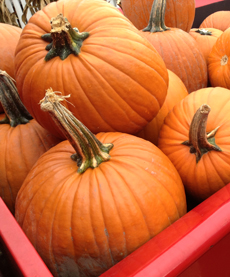TIP OF THE DAY: Pumpkin Pasta Sauce
 Pumpkin pasta sauce for fall: Buy it or make it! Photo courtesy Cucina Antica. |
Here’s a two-fer for National Pasta Month and Halloween: Tuscany Pumpkin pasta sauce from Cucina Antica. You can buy it, or make your own. The sauce can also be used to top other foods including sautéed or roasted vegetables, and to blend into mashed potatoes, rice or risotto. In Cucina Antica’s sauce, pumpkin and carrot purées and San Marzano tomatoes, seasoned with garlic, rosemary and sage, are simmered with a touch of heavy cream, onions and parsley. There are also hints of basil, cinnamon and honey. You can use it with plain pasta, stuffed pasta (gnocchi, ravioli, tortellini) or baked dishes like lasagna. At Cucina Ant5ica, they also turn it into cream of pumpkin soup with the addition of more cream or half-and-half. It’s a nice foodie gift, too, available from Cucina-Antica.com in 25-ounce jars. They sell 3-, 6- and 12-packs; a 3-pack is $16.80. Or, make your own. |
|
|
In addition to the recipe below, you can adapt the sauce to be more like Cucina Antica’s, with cinnamon and honey instead of red pepper flakes; or with cream instead of the Parmesan cheese. Or, get inspiration from this recipe from Food and Wine, which includes mascarpone cheese and toasted hazelnuts. And this recipe from Rachael Ray adds sweet sausage and white wine. RECIPE: PUMPKIN PASTA SAUCE Ingredients |
||
|
Preparation 1. COOK the pasta in a large pot of boiling salted water until al dente. Reserve 2 cups of the pasta water; then drain the pasta and set aside. 2. HEAT the olive oil in the pasta pot over medium heat. Add the rosemary and fry, stirring, until the rosemary starts to brown (1 to 2 minutes). With a slotted spoon, drain the rosemary, the leaving the oil in pot, and drain it on paper towels. It will be used as garnish, and also imparts rosemary flavor to the oil. You can use this technique whenever you are making an oil-based recipe. 3. ADD the pumpkin purée, garlic, half-and-half, Parmesan cheese, vinegar, optional red pepper flakes and 1 cup of the reserved pasta water to the pot. Take care because the oil is hot and can spatter. Stir the sauce until heated through (2 to 3 minutes). 4. ADD the cooked pasta to the sauce and toss to coat. If the sauce is too thick, add some of the reserved pasta water. Season generously with salt. Serve pasta sprinkled with fried rosemary and, if desired, more red-pepper flakes. Pumpkin originated in Central America more than 7,500 years ago. The oldest domesticated pumpkin seeds found to date were in the Oaxaca Highlands in southwest Mexico. The original pumpkins bore little resemblance to today’s large, bright orange, sweet variety; they were small and bitter. Domestication and breeding produced the pumpkins we know today. Brought to North America, pumpkins were a welcome food for the winter. Their thick skin and solid flesh were ideal for storing for consumption during months of scarcity. |

|
|
|
Europeans immigrating to New England were introduced to pumpkin by Native Americans. The first known pumpkin recipe they made was found in a book from the early 1670s. The recipe was for a side dish made from diced pumpkin, cooked down and blended with butter and spices—much like acorn squash, butternut squash and sweet potatoes are prepared today. During the 17th century, housewives developed an inventory of pumpkin recipes, the most popular of which remains [drum roll…] pumpkin pie. In the 1800s it became stylish to serve sweetened pumpkin dishes during holiday dinners. The first proclamation for “national days of prayer, humiliation, and thanksgiving” led to an observance on November 28, 1782. Since 1863, Thanksgiving has been an official annual holiday, by proclamation of President Abraham Lincoln. [Source]
|
||
